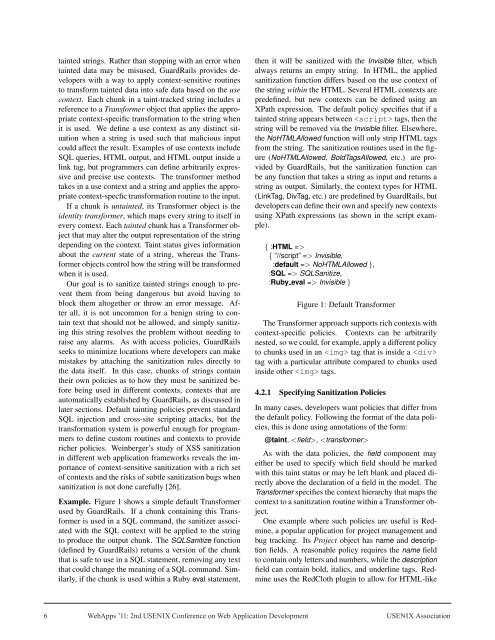2nd USENIX Conference on Web Application Development ...
2nd USENIX Conference on Web Application Development ...
2nd USENIX Conference on Web Application Development ...
You also want an ePaper? Increase the reach of your titles
YUMPU automatically turns print PDFs into web optimized ePapers that Google loves.
tainted strings. Rather than stopping with an error when<br />
tainted data may be misused, GuardRails provides developers<br />
with a way to apply c<strong>on</strong>text-sensitive routines<br />
to transform tainted data into safe data based <strong>on</strong> the use<br />
c<strong>on</strong>text. Each chunk in a taint-tracked string includes a<br />
reference to a Transformer object that applies the appropriate<br />
c<strong>on</strong>text-specific transformati<strong>on</strong> to the string when<br />
it is used. We define a use c<strong>on</strong>text as any distinct situati<strong>on</strong><br />
when a string is used such that malicious input<br />
could affect the result. Examples of use c<strong>on</strong>texts include<br />
SQL queries, HTML output, and HTML output inside a<br />
link tag, but programmers can define arbitrarily expressive<br />
and precise use c<strong>on</strong>texts. The transformer method<br />
takes in a use c<strong>on</strong>text and a string and applies the appropriate<br />
c<strong>on</strong>text-specfic transformati<strong>on</strong> routine to the input.<br />
If a chunk is untainted, its Transformer object is the<br />
identity transformer, which maps every string to itself in<br />
every c<strong>on</strong>text. Each tainted chunk has a Transformer object<br />
that may alter the output representati<strong>on</strong> of the string<br />
depending <strong>on</strong> the c<strong>on</strong>text. Taint status gives informati<strong>on</strong><br />
about the current state of a string, whereas the Transformer<br />
objects c<strong>on</strong>trol how the string will be transformed<br />
when it is used.<br />
Our goal is to sanitize tainted strings enough to prevent<br />
them from being dangerous but avoid having to<br />
block them altogether or throw an error message. After<br />
all, it is not uncomm<strong>on</strong> for a benign string to c<strong>on</strong>tain<br />
text that should not be allowed, and simply sanitizing<br />
this string resolves the problem without needing to<br />
raise any alarms. As with access policies, GuardRails<br />
seeks to minimize locati<strong>on</strong>s where developers can make<br />
mistakes by attaching the sanitizati<strong>on</strong> rules directly to<br />
the data itself. In this case, chunks of strings c<strong>on</strong>tain<br />
their own policies as to how they must be sanitized before<br />
being used in different c<strong>on</strong>texts, c<strong>on</strong>texts that are<br />
automatically established by GuardRails, as discussed in<br />
later secti<strong>on</strong>s. Default tainting policies prevent standard<br />
SQL injecti<strong>on</strong> and cross-site scripting attacks, but the<br />
transformati<strong>on</strong> system is powerful enough for programmers<br />
to define custom routines and c<strong>on</strong>texts to provide<br />
richer policies. Weinberger’s study of XSS sanitizati<strong>on</strong><br />
in different web applicati<strong>on</strong> frameworks reveals the importance<br />
of c<strong>on</strong>text-sensitive sanitizati<strong>on</strong> with a rich set<br />
of c<strong>on</strong>texts and the risks of subtle sanitizati<strong>on</strong> bugs when<br />
sanitizati<strong>on</strong> is not d<strong>on</strong>e carefully [26].<br />
Example. Figure 1 shows a simple default Transformer<br />
used by GuardRails. If a chunk c<strong>on</strong>taining this Transformer<br />
is used in a SQL command, the sanitizer associated<br />
with the SQL c<strong>on</strong>text will be applied to the string<br />
to produce the output chunk. The SQLSanitize functi<strong>on</strong><br />
(defined by GuardRails) returns a versi<strong>on</strong> of the chunk<br />
that is safe to use in a SQL statement, removing any text<br />
that could change the meaning of a SQL command. Similarly,<br />
if the chunk is used within a Ruby eval statement,<br />
then it will be sanitized with the Invisible filter, which<br />
always returns an empty string. In HTML, the applied<br />
sanitizati<strong>on</strong> functi<strong>on</strong> differs based <strong>on</strong> the use c<strong>on</strong>text of<br />
the string within the HTML. Several HTML c<strong>on</strong>texts are<br />
predefined, but new c<strong>on</strong>texts can be defined using an<br />
XPath expressi<strong>on</strong>. The default policy specifies that if a<br />
tainted string appears between tags, then the<br />
string will be removed via the Invisible filter. Elsewhere,<br />
the NoHTMLAllowed functi<strong>on</strong> will <strong>on</strong>ly strip HTML tags<br />
from the string. The sanitizati<strong>on</strong> routines used in the figure<br />
(NoHTMLAllowed, BoldTagsAllowed, etc.) are provided<br />
by GuardRails, but the sanitizati<strong>on</strong> functi<strong>on</strong> can<br />
be any functi<strong>on</strong> that takes a string as input and returns a<br />
string as output. Similarly, the c<strong>on</strong>text types for HTML<br />
(LinkTag, DivTag, etc.) are predefined by GuardRails, but<br />
developers can define their own and specify new c<strong>on</strong>texts<br />
using XPath expressi<strong>on</strong>s (as shown in the script example).<br />
{ :HTML =><br />
{ ”//script” => Invisible,<br />
:default => NoHTMLAllowed },<br />
:SQL => SQLSanitize,<br />
:Ruby eval => Invisible }<br />
Figure 1: Default Transformer<br />
The Transformer approach supports rich c<strong>on</strong>texts with<br />
c<strong>on</strong>text-specific policies. C<strong>on</strong>texts can be arbitrarily<br />
nested, so we could, for example, apply a different policy<br />
to chunks used in an tag that is inside a <br />
tag with a particular attribute compared to chunks used<br />
inside other tags.<br />
4.2.1 Specifying Sanitizati<strong>on</strong> Policies<br />
In many cases, developers want policies that differ from<br />
the default policy. Following the format of the data policies,<br />
this is d<strong>on</strong>e using annotati<strong>on</strong>s of the form:<br />
@taint, , <br />
As with the data policies, the field comp<strong>on</strong>ent may<br />
either be used to specify which field should be marked<br />
with this taint status or may be left blank and placed directly<br />
above the declarati<strong>on</strong> of a field in the model. The<br />
Transformer specifies the c<strong>on</strong>text hierarchy that maps the<br />
c<strong>on</strong>text to a sanitizati<strong>on</strong> routine within a Transformer object.<br />
One example where such policies are useful is Redmine,<br />
a popular applicati<strong>on</strong> for project management and<br />
bug tracking. Its Project object has name and descripti<strong>on</strong><br />
fields. A reas<strong>on</strong>able policy requires the name field<br />
to c<strong>on</strong>tain <strong>on</strong>ly letters and numbers, while the descripti<strong>on</strong><br />
field can c<strong>on</strong>tain bold, italics, and underline tags. Redmine<br />
uses the RedCloth plugin to allow for HTML-like<br />
6 <strong>Web</strong>Apps ’11: <str<strong>on</strong>g>2nd</str<strong>on</strong>g> <str<strong>on</strong>g>USENIX</str<strong>on</strong>g> <str<strong>on</strong>g>C<strong>on</strong>ference</str<strong>on</strong>g> <strong>on</strong> <strong>Web</strong> Applicati<strong>on</strong> <strong>Development</strong> <str<strong>on</strong>g>USENIX</str<strong>on</strong>g> Associati<strong>on</strong>








